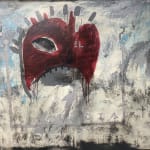




J. Roberto Diago Cuban, 1971
200.7 x 242.6 cm
Further images
In Él (Him), another painting from Juan Roberto Diago’s Lágrimas Negras series, the artist continues his exploration of Afro-Cuban identity, racial history, and resilience. This piece, which visually resembles a mask, carries a powerful duality: it is both an assertion of identity and a confrontation with the lingering specters of colonial oppression. The red tones and sharp features of the mask-like face evoke the imagery of diabolical figures, recalling both African ritual masks and Western depictions of the devil.
A striking detail in the composition is the word inscribed below, which appears to say el Diablo, yet is easily confused with Diago, the artist’s own surname. This ambiguity suggests a tension between perception and self-identification. The devilish features may reference the way Blackness has historically been demonized in Western culture, while also reclaiming the power and mysticism of African spiritual traditions. The mask, then, becomes a shield—both a protective emblem and a challenge to viewers’ preconceptions.
Within the context of the Lágrimas Negras series, which was created during the scarcity of Cuba’s Período Especial, Él also speaks to the necessity of using what is available—both in material and in historical narrative. Like the rest of the series, it embodies Diago’s ability to turn limitation into strength, making the artwork itself a metaphor for survival and reinvention. The Lágrimas Negras title once again resonates here, linking personal and collective pain to a deeply rooted cultural expression—whether through music, history, or visual art.
Ultimately, Él (Him) functions as both a self-portrait and an archetype, embodying the tensions of racial identity, cultural heritage, and the ongoing struggle for representation. The mask conceals and reveals at the same time, echoing the duality present in Diago’s entire body of work: the scars of history are not just wounds but markers of endurance and resistance.





